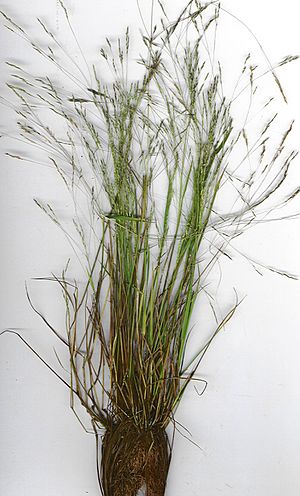Agrostis avenacea facts for kids
Quick facts for kids Agrostis avenacea |
|
|---|---|
 |
|
| Scientific classification | |
| Kingdom: | |
| (unranked): | |
| (unranked): | |
| (unranked): | |
| Order: | |
| Family: | |
| Genus: |
Agrostis
|
| Species: |
A. avenacea
|
| Binomial name | |
| Agrostis avenacea J.F.Gmel.
|
|
| Synonyms | |
|
Agrostis retrofracta, Lachnagrostis filiformis |
|
Agrostis avenacea is a type of grass that has many common names. You might hear it called Pacific bent grass, New Zealand wind grass, fairy grass, or blown-grass. It originally comes from Australia, New Zealand, and other Pacific Islands like New Guinea and Easter Island.
About Pacific Bent Grass
This grass can be found in many different places. It especially likes areas with damp soil, such as near rivers, lakes, or ponds. It has also spread to other parts of the world. These include southern Africa, the United Kingdom, Taiwan, the southern United States, and Mexico. When a plant grows in a new place where it wasn't originally, it's called an introduced species.
What Does It Look Like?
Pacific bent grass is a perennial grass, meaning it lives for more than two years. It grows in clumps, reaching up to 65 centimeters (about 2 feet) tall. Its leaves are flat and can be 8 to 25 centimeters long and 2 to 3 millimeters wide. The stems are hollow and can be round or have many sides.
The plant's flowers appear in June and July. They form a long, wispy cluster called an inflorescence, which can be 7 to 30 centimeters long. This cluster has many tiny, fuzzy parts called spikelets at the end of thin strands. Each spikelet is only two or three millimeters long.
Why Is It Important?
In its native Australia, Agrostis avenacea can sometimes cause problems. It can become a fire hazard, meaning it dries out and can easily catch fire. It can also grow near train tracks and interfere with trains.
In other parts of the world, this grass is known as an introduced species. Sometimes, it can become a noxious weed, which means it grows where it is not wanted. It is especially invasive in California, where it can take over important natural areas. For example, it can harm sensitive vernal pool ecosystems around San Diego. Vernal pools are special ponds that fill with water in the wet season and dry up later.
See also
 In Spanish: Agrostis avenacea para niños
In Spanish: Agrostis avenacea para niños

